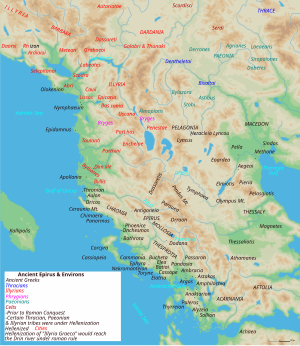Tynteni
Aspect

Tynteni, sau Tyntenoi (greacă Τυντενοί) a fost numele unui trib ilir[1][2] ce trăia într-un sat sau un oraș numit Tynte, care poate fi la fel[3] ca Daton, o colonie grecească[4] în Tracia. Tynteni și Tynte sunt atestate doar pe monede. În cazul în care era efectiv un trib, Tynteni era situat la nord[5] de lacul Ohrid. Monedele lor, a căror emisiune se oprește la începutul secolul 5 Î. hr.,[6] au similitudini cu cele ale tribului Ichnae, care în epoca arhaică era Paeonian, dar mai târziu a devenit grec. Legenda monedei este în greacă ΤΥΝΤΕΝΟΝ.
Populația atintani pare a-și avea originea[7] în obscurul Tynteni.
Vezi și
[modificare | modificare sursă]Referințe
[modificare | modificare sursă]- ^ The Ancient world, Volumes 25-26 Publisher Ares Publishers, 1994 p.112 ".
- ^ The Illyrian Atintani, the Epirotic Atintanes and the Roman Protectorate Author(s): N. G. L. HammondReviewed work(s):Source: The Journal of Roman Studies, Vol. 79 (1989), pp. 11-25.
- ^ Historia numorum: a manual of Greek numismatics by Barclay Vincent Head,1963,page 199,"suggests that Tynte may be identical with Daton."
- ^ An Inventory of Archaic and Classical Poleis: An Investigation Conducted by The Copenhagen Polis Centre for the Danish National Research Foundation by Mogens Herman Hansen, 2005, page 855, "The Thasians [...] they founded Krenides and Daton.
- ^ A History of Macedonia: 550-336 B.C by Nicholas Geoffrey Lemprière Hammond(d), Guy Thompson Griffith, page 93
- ^ The Cambridge ancient history: The fourth century B.C. by D. M. Lewis and John Boardman, 1994, page 427, "The silver coinage of the Tynteni ceased early in the fifth century.
- ^ The Cambridge ancient history: Persia, Greece and the Western Mediterranean... by John Boardman, 1988, ISBN: 0521228042, page 496, "The issuing authorities were tribes as far afield as the 'Tynteni' (later Atintani).